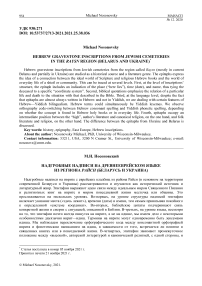Hebrew gravestone inscriptions from Jewish cemeteries in the Raysn region (Belarus and Ukraine)
Автор: Nosonovsky Michael
Журнал: Материалы по археологии и истории античного и средневекового Причерноморья @maiask
Рубрика: Эпиграфика
Статья в выпуске: 13, 2021 года.
Бесплатный доступ
Hebrew gravestone inscriptions from Jewish cemeteries from the region called Raysn (mostly in current Belarus and partially in Ukraine) are studied as a historical source and a literature genre. The epitaphs express the idea of a connection between the ideal world of Scripture and religious Hebrew books and the world of everyday life of a shtetl or community. This can be traced at several levels. First, at the level of inscriptions’ structure, the epitaph includes an indication of the place (“here lies”), time (date), and name, thus tying the deceased to a specific “coordinate system”. Second, biblical quotations emphasize the relation of a particular life and death to the situation with that described in the Bible. Third, at the language level, despite the fact that epitaphs are almost always written in Hebrew and not in Yiddish, we are dealing with certain features of Hebrew-Yiddish bilingualism. Hebrew terms could simultaneously be Yiddish lexemes. We observe orthography code-switching between Hebrew consonant spelling and Yiddish phonetic spelling, depending on whether the concept is found in Hebrew holy books or in everyday life. Fourth, epitaphs occupy an intermediate position between the “high”, author's literature and canonical religion, on the one hand, and folk literature and religion, on the other hand. The difference between the epitaphs from Ukraine and Belarus is discussed.
History, epigraphy, east europe, hebrew inscriptions
Короткий адрес: https://sciup.org/14123597
IDR: 14123597 | УДК: 930:271
Список литературы Hebrew gravestone inscriptions from Jewish cemeteries in the Raysn region (Belarus and Ukraine)
- Amosova, S. (ed.). 2015. The Shtetl of Lepel in Contemporary Cultural Memory. Moscow: Sefer.
- Beider, A. 2015. Origins of Yiddish Dialects. Oxford: Oxford University Press.
- Fishel, A., Nosonovsky, M. 2017. Rediscovered Gravestones from a Destroyed Jewish Cemetery in Ostrog: The Case of Two Inscriptions of 1445. Zutot 14, 73—87.
- Fogelman, M. 1961. Tehe nismato zerura bi-zeror ha-hayim (May his Soul be Bound in the Bundle of Life). Sinay 49, 176—180 (in Hebrew).
- iajgsjewishcemeteryproject.org: 1: Belarus. Available at: https://www.iajgsjewishcemeteryproject.org/belarus /index.html (accessed 01.11.2021).
- JEPS 2015: A gravestone with the happy end. Available at: https://news.jeps.ru/novosti/nadgrobie-s-xeppi-endom.html (accessed 2.10.2019).
- jewishgen.org: 1: Belarus Cemeteries. Available at: https://www.jewishgen.org/belarus/tools/cemeteries /index.html (accessed 01.11.2021).
- jhrgbelarus.org: 1: Jewish Heritage Research Group in Belarus. Available at: http://www.jhrgbelarus.org/ Heritage_Cemeteries.php (accessed 01.11.2021).
- Kheyfets, M. 1994. Evreyskoe nasledie Belorussii (Jewish heritage of Byelorussia). In: Dymshits, V. (ed.). Istoriya evreev na Ukraine I v Belorussii (History of Jews in Ukaraine and Byelorussia). Saint Petersburg: Jewish University.
- Kopchenova, I. (ed.). 2013. The Shtetl of Zheludok in Contemporary Cultural Memory. Moscow: Sefer.
- Kraemer, D. 2000. The Meanings of Death in Rabbinical Judaism. London; New York: Routledge.
- Krajewska, M. 1989. Cmentarze zydowskie w Polsce: nagrobki i epitafia. Polska sztuka ludowa 1-2, 27— 44.
- Muratov, I. 2009. Jewish tombstone epigraphic from Belarus. Jewish cemetery in Druya In: Chlenov, M. (ed.). Tirosh — Studies in Judaica. Vol. 9. Moscow: Sefer, 78—103 (Judaica Rossica).
- Nosonovsky, M. 1999 Hebrew epitaphs of the 16th century from Ukraine, Monuments of Culture: New Discoveries — 1998. Moscow: Nauka, 16—27 (in Russian).
- Nosonovsky, M. 2006. Hebrew inscriptions from Ukraine and former Soviet Union. Washington: Lulu.
- Nosonovsky, M. 2008. Old Jewish Cemeteries in Ukraine: History, Monuments, Epitaphs. In: Chlenov, M. (ed.). The Euro-Asian Jewish Yearbook — 5768 (2007/2008). Moscow: Pallada, 237—261.
- Nosonovsky, M. 2008. The scholastic lexicon in Ashkenazi Hebrew and orthography, Pinkas. Journal of the Culture and History of East European Jewry 2, 53—76.
- Nosonovsky, M. 2009. Folk beliefs, mystics and superstitions in Ashkenazi and Karaite tombstone inscriptions from Ukraine. Markers 26, 120—147.
- Nosonovsky, M. 2017 Evreyskie nadgrobnye nadpisi iz Glubokogo kak istoricheskij istochnik I yavlenie kul'tury (Hebrew epitaphs from Gl^bokie as a historical source and as a cultural phenomenon). In: Kopchenova, I (ed.) Glubokoe: pamyat' o evreyskom mestechke (The Shtetl of Hlybokaye in Contemporary Cultural Memory). Moscow: Sefer, 287—300.
- Reiner, A. 2011. Epitath Style of Tombstones from Würzburg Cemetery between 1147—1346. In: Müller, K., Schwarzfuchs, S., Reiner, R. (eds). Die Grabsteine vom jüdischen Friedhof in Würzburg aus der Zeit vor dem Schwarzen Tod. Neustadt: Verlagsdruckerei Schmidt, 263—295.
- Rosenthal, H, 1904. Lithuania. Jewish Encyclopedia. Vol. 8. Leon — Moravia. New York; London: Funk and Wagnalls Company, 118.
- Shapira, D. 2010. Yiddish — German, Slavic, or Oriental? Karadeniz Ara^tirmalari 6, 127—140.
- sztetl.org.pl: 1: Bielawski K. Terra incognita — Jewish cemeteries and places of martyrdom in Belarus. Available at: https: //sztetl.org.pl/en/tradycja-i-kultura-zydowska/tradycja-i-kuchnia/terra-incognita-zydowskie-cmentarze-i-miejsca-martyrologii-na-bialorusi (accessed 01.11.2021).
- van der Horst, P.W. 1991. Ancient Jewish Epitaphs: an Introductory Survey of a Millennium of Jewish Funeral Epigraphy (300 BCE — 700 CE). Kampen: Kok Pharos.
- Veidlinger, J. 2013. In the Shadow of the Shtetl.Bloomington. Indianapolis: Indiana University Press.
- Weinreich, M. 2008. History of the Yiddish Language. New Haven, CT: Yale University Press.
- Wiesemann, F. 2005. Sepulcra judaica. Bibliographie zu jüdischen Friedhöfen und zu Sterben, Begräbnis und Trauer bei den Juden von der Zeit des Hellenismus bis zur Gegenwart. Essen: Klartext Verlag.
- Wodzinski, M. 1998. Groby cadykow w Polsce. O chasydzkiej literaturze nagrobnej i jej kontekstach. Wroclaw: Towarzystwo Przyjaciol Polonistyki Wroclawskiej.


